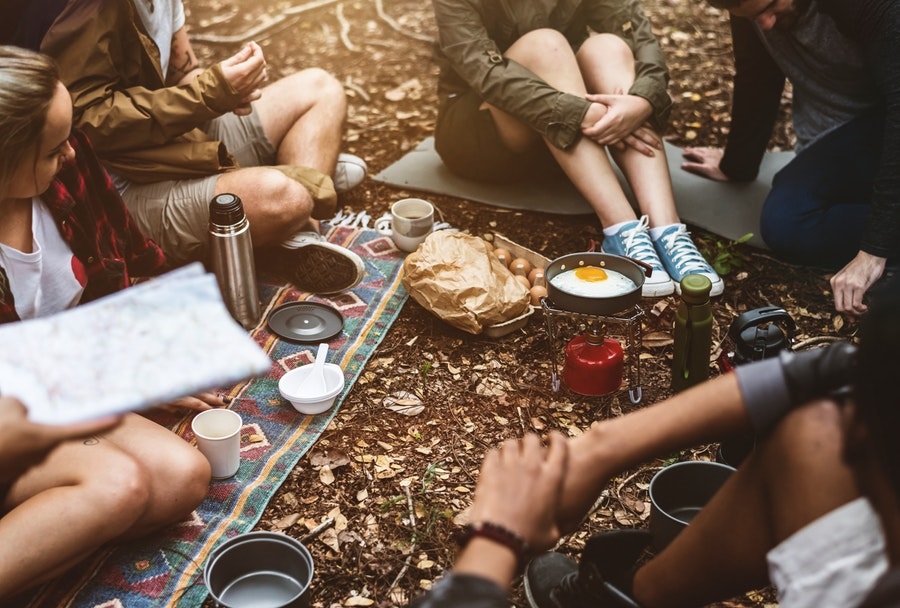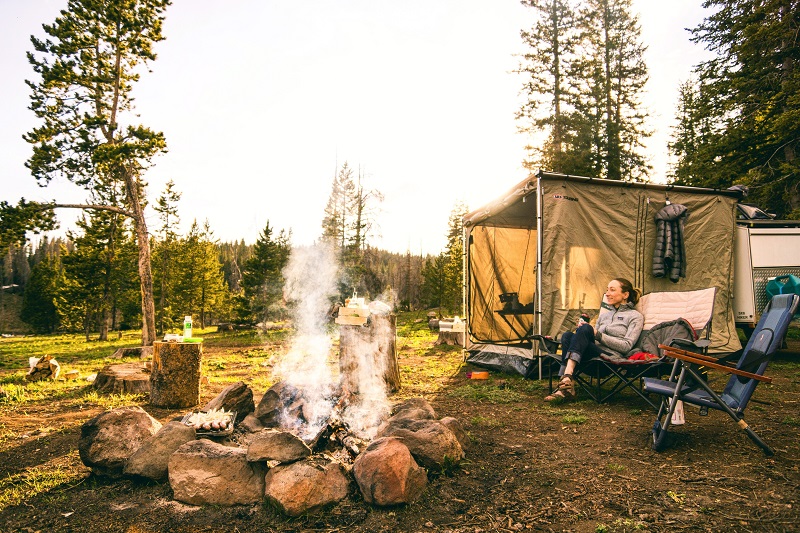When traveling by plane for a camping holiday it’s hard to know what to take and what you are allowed to fly with. I have to admit, way back when I started flying places to camp I didn’t think I would be allowed to take much at all.
It turns out that I was completely wrong. In fact the list of camping items that you are not allowed is quite short. There will be certain items that you will have to check in but majority can be carried on, as long as it’s not too bulky.
The camping items that you can’t fly with are bear bangers, bear spray, fire starter gel, or torch lighters. Propane cylinder are allowed as long they are completely empty, however, my advice is to leave the cylinder behind and get a new one when you get there.
Do you need to take camping gear at all?
Just because you can take everything you might need doesn’t mean you should. Camping equipment can be quite bulky and heavy depending on what activities you are planning to do. This could result in extra costs from the airline.
Backpacks are not really designed for air travel either. The lose straps and lightweight material mean that they are susceptible to damage so they usually need to be handled differently.
The easiest way to avoid all of this is to see if you can rent your equipment when you get to your destination. A quick google search will tell you if this is possible.
Although, camping gear may be harder to find, especially in places where camping isn’t a big thing, if you are travelling to a place to do some activity, such as rock climbing, then you should have no issue finding that sort of equipment to rent.
So What Are You Allowed?
I have gone through the entire TSA website and listed anything here that is relevant to camping.
Camping items you can carry on board.
- Air Mattress with built-in pump – Just check with the airline for size and weight restrictions.
- Bug Repellent- You can carry on small amounts (3.4oz / 100ml). If you want to take more then you will have to check it in.
- Camping Stove – These are allowed to be carried on as long as they are empty of all fuel and cleaned so that no fuel vapors or residue remain.
- Fork or spork – Just double check at check-in.
- Plastic or round bladed butter knife – Sharp knives will need to be checked in.
- Multi-tool without blades – Small scissors are allowed
- Navigation GPS
- Pots and pans- Lightweight camping pots and pans will not be an issue but if you want to take a heavy cast iron skillet then this will need to be checked in.
- Safety Matches – You will be allowed one box in your carry on baggage. This is one of the few items where you are allowed to carry on but they are prohibited to be store with your checked items.
- Sleeping bag – As long as it is not too bulky. There is size restrictions to all carry on baggage
- Tent – Check with your airline for size restrictions. Metal tent pegs/stakes and poles will need to be checked in so you might be as well just checking in the whole tent.
- Head Lamp
Camping items that need to be check in.
- Aerosol Insecticide – These are only allowed in checked bags, however if they have a hazardous material label on it then you will have to leave it behind.
- Axes and Hatchets – These will have to be checked
- Hammers and Mallets
- Hiking Poles
- Knives – Sharp objects need to be checked and should be sheathed to prevent injury to baggage handlers and inspectors
- Multi- tool with blade
- Pocket Knife
- Metal tent pegs and poles
This list is all the tsa have on their website in regards to camping. If you have any further camping queries then contact your airline.
Checking your pack onto the plane.
As mentioned above, when traveling to do some activity I suggest renting when you get there. It’s a lot less hassle than checking in lots of awkwardly shaped equipment. There is also a high risk of items getting damaged while in transport.
Have you ever seen baggage handlers taking bicycles from a plane? Everytime I see them, they throw the bikes down onto the ground on top of each other from a height. In my opinion, they have no respect for what other people’s things.
However, there will be some of you will insist on taking you own stuff. Just make sure you are well packed in hard cases if possible.
If I’m flying and I have friends near to where I will be hiking, I sometimes put all of my stuff, backpack included, in a normal suitcase. I can then check in the bag as normal, but of course declare any dangers or potentially hazardous items. If you don’t declare such items then your bag could be confiscated.
Whenever I make it to my friend house I assemble my kit and leave the suitcase in their house until I return.
Another method I use if I don’t have somewhere to stash my suitcase is to use a compactor bag. First, I pack my backpack with all the things I will need for my camp. Then I reduce the amount that the straps stick out. I buckle mine and then tighten all traps up full and then tuck all the loose ends in wherever I can.
Once you are happy that the straps are secured, then place your backpack into a compactor bag. Squeeze as much air as possible out of it and simply tie a knot at the top of the bag. The function of the bag it the stop your straps getting caught of the airport conveyors and to make sure any items that you might have in the outside pockets stay secure. A compactor bag is pretty robust but you can use another bag if you want extra security. Once you land you can bin the bags and start hiking straight away.
Some people don’t trust the compactor bags and will use a lightweight duffle bag instead. This is also a good method but it means you will be carting that duffle bag around with you for the entire camp.
Flying with guns and ammo
If you are going on a hunting trip and insist on bringing your own equipment then you will have to follow strict guidelines laid out by your airline. Even if you have flown with firearms before, always check before you flight. Most airline want your guns to be secured in a hard lockable box, some want you to pack the ammo with your gun while others insist that you keep them seperate.
Also, make sure that it is legal to possess a firearm in your destination. There are many places around the world that this is illegal without the proper documentation.
Conclusion
When flying anywhere your goal should, as always, pack as lightly as possible. If that means buying new light weight gear then do that. Maybe you can take most of your gear and rent some of the heavier equipment when you get there.
Whenever I am flying for a camp I have all I need on my carry-on to last me a four day camp. It can be expensive and may take time to gather good light weight equipment that will compress down small.
Try to use items for more than one purpose. For example, I have a compression bags that is fleece lined on the inside so I can turn it inside out and use it as a pillow.
Over time you will see that a lot of the stuff you take just isn’t needed and you will have a lean backpack that can be carried onto any plane.
For more details of how you the lighten your backpack the read my post here.
If you have found this article helpful then please remember to share by clicking on one of the buttons below. It will help others find this article too.



